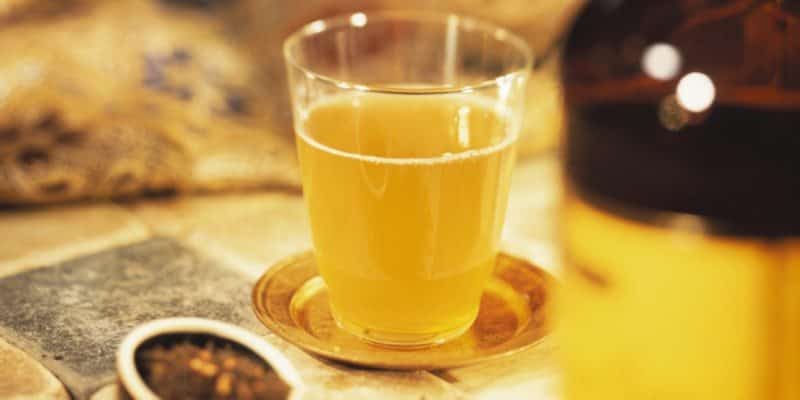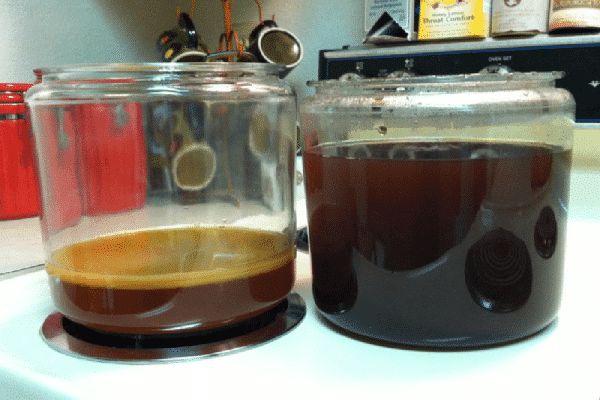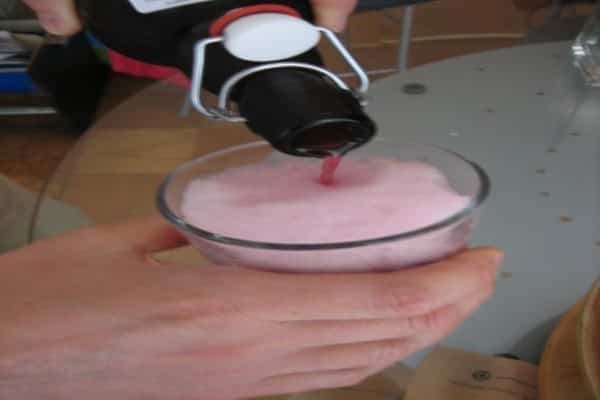How To Flavor Your Kombucha To Awesomeness
You have three different opportunities to adjust the flavor of your kombucha:
- during the primary fermentation (brewing)
- during the secondary fermentation
- right before you drink the kombucha
The last is the easiest, of course – just mix your kombucha with sparkling water, fruit juice, or flavoring syrups. You can even use kombucha to make cocktails and mixed drinks, or use it in cooking. But you’ll get the most interesting flavors, and ones with the most depth and complexity, when you experiment with different techniques and ingredients during the primary or secondary fermentation of your kombucha tea.
Ways to Flavor Kombucha During the First Fermentation Stage

In this first stage, it’s best to just work with one or all of these three things: the tea you use, the sugar you use, and the length of time you let the fermentation continue. While some people have had good results from adding different ingredients during primary fermentation (for example, adding fresh ginger to the sweetened tea) it’s best to wait until the secondary fermentation stage to do this. Introducing anything other than the tea and sugar into the liquid increases the chance that the kombucha will become contaminated by bad bacteria or mold, and your SCOBY (the Symbiotic Colony Of Bacteria and Yeast) could be harmed.
NOTE: Before experimenting with these techniques, it’s a good idea to build up a supply of SCOBYs in your SCOBY hotel, just in case something goes wrong.
Change the Tea
The type of tea you use will change the flavor of the kombucha, and will also have an effect on the brewing time, especially if you make a stronger or weaker brew out of the tea. The best tea for kombucha comes from the Camellia sinensis plant, the true “tea” plant that produces black and green tea. Here’s an overview of the different varieties of tea:
Black tea. This is tea that has been heated and dried so that the volatile compounds in the leaf are almost completely oxidized. There are many types of black tea, classified according to the exact method used to process the tea leaves, but all will give you a strong, well-flavored brew. Because of the tannins in black tea, you may need to adjust the steeping time so that you don’t end up with kombucha tea that’s too bitter.
Green tea. The leaves for green teas are picked whole and then usually steamed before being dried. SCOBYs love green tea because it’s full of nutrients. There is less caffeine in green tea than in black tea. This tea will give your kombucha a “grassy” flavor and a slightly bitter edge, especially if you use a stronger brew.
White tea. The lightest of the teas, this sweet and delicate tea is made out of whole leaves and buds that are carefully dried to retain their flavor. Low in caffeine and high in antioxidants, white tea will give your kombucha a slightly floral note without any of the bitter or tannic flavors that the darker teas can have, especially after long steeping.
Oolong tea. When the harvested tea leaves are exposed to strong sunlight for several days before being heated, the oxidation process is quicker and gentler, leaving tea that has more subtle flavors. Oolong tea can be mild to strong, depending on how much time was spent in oxidation and the way the tea was processed. The flavor ranges from sweet to woody to roasted.
Pu-erh tea. This black tea has the strongest and most complex flavors, because it has been fermented for several months or even years. Deep, rich, and even smokey, this is a good tea to experiment with in small amounts, blended with other teas. Using pu-erh alone may result in a finished kombucha tea that’s too intense for some people.
Yerba mate and rooibos. Although these are not true “tea” varieties from the Camellia sinensis plant, they have an equally long history as refreshing and healthy brewed drinks. Yerba mate comes from South America, and rooibos from South Africa. Both are made from the leaves of bushes common to those regions. Yerba mate contains caffeine, so you can use it as a substitute for any of the true teas. However, rooibos does not contain caffeine but still has many (but not all) of the ingredients your SCOBY needs to grow, so it can be used to brew CAFFEINE-FREE kombucha. Keep in mind that for the long term health of your SCOBY, you will need to occasionally rotate Rooibos tea with regular tea otherwise your SCOBY may suffer health issues.
Herbal tisanes. While people say “herb tea” these are not actually teas, but instead are “tisanes” made by steeping herbs and/or spices in hot water. Avoid using herbs, spices, or packaged herbal teas that are high in oil (peppermint, spearmint, sage, cinnamon, citrus, lemongrass) or that are flavored with essential oils or artificial ingredients. The oils will interfere with the SCOBY.
How to Change the Tea
You can mix any of the teas that contain caffeine in any proportion you like to get the flavor you want, as long as you stick to the standard kombucha brewing ratio . It’s a good idea to take notes of how much of each kind of tea you’re using, so that you have a record of what you like, what you don’t like, and how the different tea blends affect the brewing time as well as the final result.
If you want to add herbal tisanes during the first fermentation, keep in mind that the SCOBY needs the caffeine and nutrients in true tea leaves for the best results. If you’re brewing kombucha and most or all of your tea is herbal, your SCOBY will weaken over time. Start by replacing 25% of the regular tea with an herbal blend, and see if you like the results. If you do brew a mostly-herb batch, make sure the next batch contains mostly regular tea.
Change the Sugar
Changing the sugar can either significantly affect the taste of your Kombucha (or not at all, depending on the type of sugar).
The SCOBY needs sugar for food while it’s working on processing the nutrients in the tea, and the best sugar for brewing kombucha is white cane sugar that has been treated enough to refine the sucrose crystals, but still has a good percentage of the natural minerals in the sugarcane. Look for evaporated cane juice or raw white sugar and use that as your basic sugar source when you’re growing a new SCOBY and then start experimenting with replacing some or all of that sugar with different types of sweetener.
Special Sugars for unique flavors
You can use pasteurized honey, agave syrup, palm sugar, molasses, brown sugar, and maple syrup. These will all affect the flavor as well as the brewing time: the more refined a sugar is, the quicker it will be processed and the less flavor it will add.
No artificial sweeteners or natural sweeteners with no glucose
Don’t use stevia or artificial sweeteners, because they do not contain the sucrose (fructose and glucose) that the SCOBY needs to survive. The SCOBY processes most of the sugar in kombucha during fermentation, but if you’re worried about sugar in your diet, there are ways to make sugar-free kombucha.
Change the Fermentation Time
As the kombucha ferments, the SCOBY transforms the sugar into the acids and probiotics that make kombucha such a healthy drink. It takes between 3 and 30 days to fully ferment, and as long as your kombucha keeps an average pH of between 2.5 and 4.5 your finished kombucha is safe to drink.
Fermenting for a shorter time gives you a sweeter brew, and if you’re going to do secondary fermentation (see below) then you’ll probably want to stop the primary fermentation while there’s still a bit of sugar left, though you can always add more.
Fermenting for a longer time gives you a tartier brew. The longer you ferment, the more sugar is used up by the SCOBY for food and the less sweet the brew is. It’s up to you to determine how sweet or tart you like your ‘buch.’ Note that there are a different set of nutrients released by the SCOBY in longer brews then shorter ones, so the nutrient profile won’t be the same. You can reap the benefits of both short term brew nutrients and long term brew nutrients if you use a continuous brewing system which will have new + old kombucha mixed in all the time.
Fermentation Temperature
How long the fermentation takes also depends on the temperature. When it’s warmer, the yeasts and bacteria in the SCOBY are more active, and they will process the sugar and nutrients more quickly. However, when it’s too hot, the yeasts may work too fast and create more byproducts (ethanol and carbon dioxide) than the bacteria can handle, which will give you a sour, “yeasty” kombucha tea.
On the other hand, when it’s too cool, the SCOBY slows down. If it’s too cold, the SCOBY will almost completely shut off, and may die. You’ll need to keep the SCOBY warm during the fermentation process. For the best results, keep the brewing container and the SCOBY at room temperature, or between 65F and 80F.
Slow and Steady
You can slow down / control the fermentation by lowering the temperature, by giving the SCOBY less sugar (or a less refined sugar), or both in combination. A longer fermentation time will often give you a more complex flavor. As long as the pH is between 2.5 and 4.5 there is only a small risk that the kombucha will be contaminated by bad bacteria, as long as you keep the container covered with a tightly-woven cloth.
By tasting the kombucha every day, you’ll be able to see exactly when the SCOBY runs out of its main source of food (the sugar you added) and starts to process the residual sugars in the liquid. At that point, the brew will only get more and more acidic.
Container Shape
It’s important to mention the shape of the container you are brewing your Kombucha in may affect the flavor profile. A container with a very wide opening (surface area) will allow more air contact with your SCOBY. This will affect your brew time quite a bit. The wider your container opening, the faster your ‘buch’ will brew. Conversely, the more narrow your opening, the slower your kombucha will ferment.
However, having a quicker ferment due to a very wide container opening is not always a good thing. You could end up with a brew that ferments too fast and because of this, a very yeasty flavor (yeast works too fast and creates too many by products — see the section above on Ferment Temperature — same principal applies).
Many Kombucha brewers recommend a (glass) container that’s somewhat shallow with a larger opening — big enough to allow lots of contact with the air but not too big.
Ways to Flavor Kombucha During the Second Fermentation Stage
When your kombucha tea has reached the perfect sweet-acid balance, remove the SCOBY and start adding flavor. You can either drink the tea immediately, mixed with fruit juice or other flavoring, or continue the fermentation process. Doing a second fermentation is also the best way to add carbonation to kombucha.
Unlike the first fermentation, secondary fermentation is anaerobic, which means that you will be sealing the container with a tight lid instead of a woven cloth covering. This allows the carbonation to build up and also protects the tea from contamination after the SCOBY is removed. Because you’ve taken the SCOBY out of the container, you can add nearly any type of flavoring to get good results: fresh fruit, dried fruit, juices, herbs, spices, flowers (fresh or dried), and even vegetables.
IMPORTANT: Because of the amount of increased carbonation in secondary fermentation, you need to use tightly-sealed bottles that you can “burp” easily to release the excess pressure. It’s a good idea to talk to someone at a brewing supply store to learn about the best bottles for kombucha and other carbonated drinks.
Here are the basic steps to doing second fermentation:
- Remove the SCOBY from the brewing container.
- Add your flavorings to the kombucha tea.
- Add extra sugar (optional).
- Leave the tea at room temperature for 24 to 72 hours.
- Check regularly for excess carbonation buildup.
- Strain out the flavoring ingredients (optional).
- Refrigerate the bottles for longer storage.
What Flavors to Add?
What flavors do you like? You can add almost anything to the kombucha tea, as long as you use common sense. In other words, if you want to add lemon zest as a flavoring, make sure that you have removed the bitter white pith, so that this bitterness doesn’t end up in the finished tea. Keep in mind that the stronger the flavor of the ingredient, the more the tea will end up with that flavor.
A half stick of cinnamon will add a lovely spicy note to the tea, but adding a handful of cinnamon sticks may give you a tea that’s so spicy it’s undrinkable.
We find that spices and herbs tend to add the biggest infusion to flavor and taste. Fruit juices add a nice secondary flavor. You can combine all three to really change up the flavors. For example, ginger + cinnamon + freshly juiced apples combines a herb (ginger), a spice (cinnamon), and a fruit juice (apple juice).
Some combinations work better than others — you’ll just have to experiement. We’ve found that ginger makes one of the best herbal base — either on it’s own or combined with a fruit juice and or fruit juice + herb. Other spices that taste good: lavender. cocoa. Herbs that do well in Kombucha: ginger, chili peppers, rosemary, mint leaves.
This is another reason to take notes when you’re brewing – you’ll want to remember what you like and what didn’t work. The secondary fermentation is like cooking using a recipe. If you can’t find a recipe you like, then create your own!
Add Extra Sugar
When you add extra sugar, you give the yeasts in the kombucha tea more food that they transform into carbon dioxide (CO2) and alcohol. You’ll get better carbonation if you add a little sugar before sealing your container or bottles, especially if you have left the primary fermentation go long enough to create a more sour or acidic brew. Adding more sugar also speeds up the process of secondary fermentation.
You don’t need to add in sugar though, if the first fermentation still leaves a brew that’s sweet (usually about 7 days to 14 days of fermentation. Longer and the brew starts to taste more tart).
You can also add in fruit or fruit juice instead of sugar.
Add Fruit or Fruit Juice
If you don’t want to directly add extra sugar, you can use a fruit or fruit juice as the sugar source instead (if you add fruit juice or fruit, don’t add sugar). Most people who do a secondary ferment opt for fruit or fruit juice to feed the second ferment and infuse more carbonation.
Add In Herbs and Spices
You can mix in herbs and spices to infuse extra flavor into your brew. In fact, we highly recommend you do. The best Kombucha we find usually has something potent like ginger or chilies or some strong herb mixed in with some subtle spice to add an extra kick of flavor.
More Secondary Ferment Ideas
To Strain or Not to Strain
You can strain out the ingredients you’ve added before bottling, but it’s not always necessary. However, leaving these extra ingredients in may create mold, especially if you’ve used fresh fruits or whole spices. Leaving the ingredients in will also continue any secondary fermentation process longer, which will give you a different flavor in the end.
Refrigeration
When you refrigerate the kombucha you’ll slow down or stop the secondary fermentation. The longer you leave it at room temperature, the more carbonation will build up. It’s a good idea to refrigerate the finished flavored kombucha if you’re not going to drink it within a week.
Sample Flavor Combinations
Here are some ideas for delicious flavored kombucha tea using different types of tea, sugar, and flavoring ingredients:
- Pineapple Fizz Kombucha: green tea, raw cane sugar, pineapple chunks, fresh ginger
- Gingerbread Kombucha: lapsang souchong black tea, cane sugar, molasses, ginger, cloves
- Super Antioxidant Kombucha: matcha green tea, coconut sugar, açaí puree, cranberry juice
- Irish Cream Kombucha: Irish Breakfast tea, cane sugar, coffee beans, vanilla bean, bourbon extract
- Mamma Mia Kombucha: black tea, honey, fresh tomatoes, basil, hot pepper flakes
- Rosemary Watermelon Kombucha: green tea, fresh watermelon, fresh rosemary sprigs, agave syrup
- Cucumber Kombucha: green tea, rice syrup, lemon zest, sliced cucumber, fresh dill
- ABC Kombucha: oolong tea, honey, sliced apricots, blueberries, cantaloupe chunks, fresh mint














